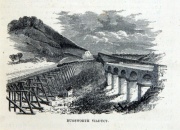Bugsworth Viaduct

or Buxworth Viaduct
Part of the Midland Railway
1902 'THE HISTORY OF THE ROWSLEY, BUXTON AND NEW MILLS LINE. CLEMENT E. STRETTON C.E. ..... In 1866 the line was completed and opened for goods traffic, but in the autumn of that year after a period of exceptionally heavy rainfall all over the country, there were signs of an extensive land movement at Bugsworth Viaduct, a solid structure of masonry of five arches, the whole having a curve towards the hillside. The great saturation beds had caused them to slip on some harder rocks underneath, and it was observed that the whole hillside was moving, and that the curved viaduct had been forced by the immense moving mass into a straight line. Traffic was at once suspended, and the responsible engineers anxiously waited for the completion of this great earth movement. A length no less than 16 acres of land slid bodily down the slope carrying with it the whole of the substantial viaduct. Tunnels were formed by the engineers to divert the water underground, and 400 men were engaged day and night for a period of ten weeks constructing a new viaduct of timber to replace the one which had been swept out of the course of the line. This work having been successfully carried out the Midland route to Manchester was at length opened for passenger traffic on the 1st of February, 1867.'[1]
The wooden viaduct contained 50,000 feet of pitch pine from the Baltic, and lasted from 1866 until 1885. The line was permanently diverted to the back (north side) of Bugsworth Station. The diversion required the construction of an embankment through Brierley Green, composed of 32,000 tons of stone, clay and earth and 25,000 tons of ashes.[2]

